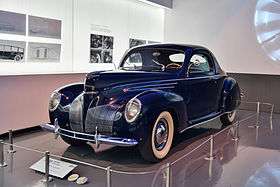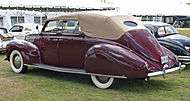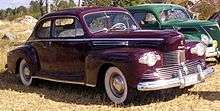Lincoln-Zephyr
| Lincoln-Zephyr | |
|---|---|
 | |
| Overview | |
| Manufacturer | Lincoln (Ford) |
| Production | 1936–1940 |
| Assembly | Lincoln Assembly, Detroit, Michigan |
| Body and chassis | |
| Class | Mid-size luxury car |
| Body style |
4-door sedan 4-door convertible sedan 2-door sedan 2-door coupe 2-door convertible coupe |
| Related | Lincoln Continental |
| Powertrain | |
| Engine | 267 cu in (4.4 L) L-head 110 hp (82 kW) V12[1][2] |
| Transmission | 3-speed manual[2] |
| Dimensions | |
| Wheelbase | 122–125 in (3,099–3,175 mm)[2] |
| Length | 202.5–210 in (5,144–5,334 mm)[2] |
| Height | 69 in (1,753 mm) [2] |
| Chronology | |
| Successor | Lincoln Continental Mark series |
The Lincoln-Zephyr is a marque that was used for the lower-priced line of mid-size luxury cars in the Lincoln line from 1936 until 1940. Lincoln-Zephyr and Mercury, introduced in 1939, bridged the wide gap between Ford's V-8 De Luxe line and the exclusive Lincoln K-series cars. This served a purpose similar to Cadillac's smaller LaSalle "companion car", the Chrysler Airstream, and Packard's smallest offering, the Packard One-Twenty. Its appearance is similar to the Pierce Silver Arrow of which only five were built. The car was conceived by Edsel Ford[3] and designed by Eugene Turenne Gregorie. The Zephyr was unique in this class having a V-12, while the LaSalle had a V8 engine, and the Chrysler and Packard has straight 8 engines.
Overview

Introduced on November 2, 1935,[3] as a 1936 model, the Lincoln-Zephyr was extremely modern with a low raked windscreen, integrated fenders, and streamlined aerodynamic design, which influenced the name "zephyr", derived from the Greek word zephyrus, or the god of the west wind. It was one of the first successful streamlined cars after the Chrysler Airflow's market resistance. In fact, the Lincoln-Zephyr actually had a lower coefficient of drag than the Airflow, due in part to the prow-like front grille on the Zephyr. The Lincoln-Zephyr succeeded in reigniting sales at Lincoln dealerships in the late 1930s, and from 1941 model year, all Lincolns were Zephyr-based[4] and the Lincoln-Zephyr marque was phased out. Annual production for any year model was not large, but accounted for a large portion of the Lincoln brand's sales. In its first year, 15,000 were sold, accounting for 80% of Lincoln's total sales.
Production of all American cars halted in 1942 as the country entered World War II, with Lincoln producing the last Lincoln Zephyr on February 10.[5] After the war, most makers restarted production of their prewar lines, and Lincoln was no exception. The Zephyr name, however, was no longer used after 1942, with the cars simply called Lincolns.
The idea of a smaller and more modern luxury car to fill the gap in Lincoln's traditional lineup was revisited in the 1950 Lincoln Lido (The Lido was the same size as other two-door Lincolns, though[6]), 1977 Lincoln Versailles, 1982 Continental, and 2000 Lincoln LS. The Zephyr name itself was resurrected for the car's spiritual successor in 2006, though this modern Zephyr was quickly renamed MKZ for 2007.
Gallery
-

Lincoln-Zephyr V-12 four-door sedan 1936
-

Lincoln-Zephyr V-12 coupe 1937
-

Lincoln-Zephyr V-12 four-door sedan 1938
-

Lincoln-Zephyr V-12 convertible coupe 1938
-

Lincoln-Zephyr V-12 convertible sedan 1938
-

Lincoln-Zephyr V-12 four-door sedan 1939
-

Lincoln-Zephyr V-12 convertible coupe 1939
-

Lincoln Zephyr club coupe 1942
Models
- Lincoln-Zephyr V-12 (1936–1940)
- For 1936, available as two-door sedan or four-door sedan, a locking glove box was standard.[7] Radio was optional. The turning radius was 22 feet (6.7 m).[8] For 1937 the 2-door Sedan was renamed Coupe-Sedan, a Coupe (3-Window) was added along with a formal Town-Limousine. For 1938 a Convertible Coupe and a Convertible Sedan was added. For 1940 the Coupe-Sedan was replaced by the Club Coupe, the Convertible Sedan was discontinued. Trunk space was increased in 1940.[9]
- Lincoln-Zephyr Continental (1940) was the first time the name Continental appeared on a car from Lincoln, as a model under Lincoln-Zephyr rather than a separate model. They were partially hand-built since dies for machine-pressing were not constructed until 1941. Production started on December 13, 1939, with the Continental Cabriolet, from June 1940 also available as Continental Club Coupe. Just 350 Cabriolets and 54 Club Coupes were built.[10]
When the last Lincoln V-12 (Model K) had been delivered on January 24, 1940,[11] the Lincoln Motor Company was soon to be transformed into Lincoln Division, effective on May 1, 1940,[12] and for 1941 model year the Lincoln-Zephyr was no longer a separate marque. All 1941 models were Lincolns and the Zephyr-based Lincoln Custom replaced both the large Lincoln K-series cars and the Lincoln-Zephyr Town-Limousine. It also had full instrumentation.[13]
The following models sold under Lincoln marque, but they have their heritage in the Lincoln-Zephyr:
- Lincoln Zephyr V-12 (1941–1942) Both years available as Sedan, Coupe, Club Coupe and Convertible Coupe
- Lincoln Custom (1941–1942) Sedan and Limousine, some with blinded quarter roof option[14]
- Lincoln Continental (1941–1948) Cabriolet and Coupe
- Lincoln (1946–1948)

The Lincoln Zephyr V-12 is an automobile that was produced by Lincoln from 1941-1942. It was inherited from Lincoln-Zephyr when the two marques were merged for the 1941 model year.[15] When Lincoln resumed production after World War II the model name Zephyr was dropped[16] and the cars sold without a proper model name, known just by their body style during the 1946-1948 model years.
After the war, the cars were no longer named Zephyr[17] nor did they have any other model name, they were simply known by their body styles: Sedan, Club Coupe, or Convertible Coupe. For identification purposes, they are typically referred to as the H-Series.
Specifications
.jpg)
Designed by John Tjaarda (1897–1962), who was fascinated with airplanes, with a drag coefficient of 0.45 and unibody construction, relatively light and rigid for its size. The first model had a weight of 3,350 lb (1,520 kg).
The Zephyr was powered by a small 75° V12 engine[2] developed from Ford's Flathead V8 and unrelated to the larger K-series Lincoln V12 engines. The valve-in-block flathead engine was quite compact, allowing a low hood. But like the V8 Fords of the era, the Zephyr V12 often suffered from hot spots due to exhaust passages through the cylinder block. In addition, the earliest Zephyrs suffered from poor oil pressure, resulting in upgrades to the oil pump.
The 1936 to 1939 models were 267 in³ (4.4 L) with hydraulic lifters added in 1938. The 1940 and 1941 cars used an enlarged 292-in³ (4.8-L) engine, while 1942 and early 1946 models used a 306-in³ (5.0-L), but lower compression ratio because of the iron heads. Late 1946 to 1948 Lincolns based on the Zephyr used a 292-in³ engine.
The original engine had 110 hp (82 kW) and gave the car a top speed of 90 miles per hour (140 km/h). Suspension was by Henry Ford's beloved transverse springs front and rear, with dead axle front and torque tube rear, already seen as outdated when the car was introduced. Brakes were cable-activated for 1936 to 1938; 1939 and onwards were hydraulic. The Zephyr was the first Ford product to have an all-steel roof, except the late 1931 Model AA truck.
In fiction
A yellow 1938 convertible appeared in The Adventures of Tintin comic "The Seven Crystal Balls".
A 1937 three-window coupe is used for the Black Beauty in both The Green Hornet (serial) and The Green Hornet Strikes Again!.
See also
References
- ↑ "Directory Index: Lincoln/1936_Lincoln/1936_Lincoln_Zephyr_Folder". Oldcarbrochures.com. Retrieved 2011-12-31.
- 1 2 3 4 5 6 Kimes, Beverly (1996). standard catalog of American Cars 1805-1942. Krause publications. ISBN 0-87341-428-4.
- 1 2 Dammann & Wagner Cars of Lincoln-Mercury, p. 155
- ↑ Dammann & Wagner Cars of Lincoln-Mercury, p. 206
- ↑ Dammann & Wagner Cars of Lincoln-Mercury, p. 216
- ↑ Dammann & Wagner Cars of Lincoln-Mercury, p. 246
- ↑ "Directory Index: Lincoln/1936_Lincoln/1936_Lincoln_Zephyr_Folder". Oldcarbrochures.com. Retrieved 2011-12-31.
- ↑ http://www.oldcarbrochures.com/static/NA/Lincoln/1936_Lincoln/1936_Lincoln_Zephyr_Folder/1936%20Lincoln%20Zephyr-04.html
- ↑ "Directory Index: Lincoln/1940_Lincoln/1940_Lincoln_Zephyr_Brochure_1". Oldcarbrochures.com. Retrieved 2011-12-31.
- ↑ Dammann, George H.; Wagner James K. (1987). The Cars of Lincoln-Mercury. Crestline Publishing Co. pp. 203–204. ISBN 0-912612-26-6.
- ↑ Dammann & Wagner Cars of Lincoln-Mercury, p. 205
- ↑ Dammann & Wagner Cars of Lincoln-Mercury, p. 199
- ↑ "Directory Index: Lincoln/1941_Lincoln/1941_Lincoln_Zephyr_Brochure". Oldcarbrochures.com. Retrieved 2011-12-31.
- ↑ Dammann & Wagner Cars of Lincoln-Mercury, p. 214
- ↑ Dammann, George H.; Wagner James K. (1987). The Cars of Lincoln-Mercury. Crestline Publishing Co. p. 199. ISBN 0-912612-26-6.
- ↑ Dammann, George H.; Wagner James K. (1987). The Cars of Lincoln-Mercury. Crestline Publishing Co. pp. 223–224. ISBN 0-912612-26-6.
- ↑ Dammann & Wagner Cars of Lincoln-Mercury, pp. 223–224
Further reading
- Bonsall, Thomas. The Lincoln motorcar, Sixty Years of Excellence.
- David L. Lewis (2005). 100 Years of Ford. Publications International. ISBN 0-7853-7988-6.
- Dammann, George H.; Wagner, James K. (1987). The Cars of Lincoln-Mercury. Crestline Publishings. ISBN 0-912612-26-6.
| Wikimedia Commons has media related to Lincoln Zephyr. |
External links
- Lincoln-Zephyr Owners Club
- The Old Cars Manual Project Original Lincoln and Lincoln-Zephyr sales material for comparison.
| Lincoln passenger vehicle timeline, 1922–1979 — next » | |||||||||||||||||||||||||||||||||||||||||||||||||||||||||||
|---|---|---|---|---|---|---|---|---|---|---|---|---|---|---|---|---|---|---|---|---|---|---|---|---|---|---|---|---|---|---|---|---|---|---|---|---|---|---|---|---|---|---|---|---|---|---|---|---|---|---|---|---|---|---|---|---|---|---|---|
| Type | 1920s | 1930s | 1940s | 1950s | 1960s | 1970s | |||||||||||||||||||||||||||||||||||||||||||||||||||||
| 2 | 3 | 4 | 5 | 6 | 7 | 8 | 9 | 0 | 1 | 2 | 3 | 4 | 5 | 6 | 7 | 8 | 9 | 0 | 1 | 2 | 3 | 4 | 5 | 6 | 7 | 8 | 9 | 0 | 1 | 2 | 3 | 4 | 5 | 6 | 7 | 8 | 9 | 0 | 1 | 2 | 3 | 4 | 5 | 6 | 7 | 8 | 9 | 0 | 1 | 2 | 3 | 4 | 5 | 6 | 7 | 8 | 9 | ||
| Mid-size | WWII | Versailles | |||||||||||||||||||||||||||||||||||||||||||||||||||||||||
| Entry-level | Lincoln-Zephyr | Zephyr | H-Series | EL-Series | Cosmopolitan | Custom | Capri | Capri | |||||||||||||||||||||||||||||||||||||||||||||||||||
| Full-size | Cosmopolitan | Capri | Premiere | Premiere | Continental | Continental | |||||||||||||||||||||||||||||||||||||||||||||||||||||
| L-Series | Continental Mark III–V | ||||||||||||||||||||||||||||||||||||||||||||||||||||||||||
| Limousine | L-Series | K-Series | Custom | ||||||||||||||||||||||||||||||||||||||||||||||||||||||||
| Halo car | K-Series | Continental Mark IV–V | |||||||||||||||||||||||||||||||||||||||||||||||||||||||||
| Personal luxury car | Continental | Continental | Continental Mark II | Mark III | Mark IV | Mark V | |||||||||||||||||||||||||||||||||||||||||||||||||||||